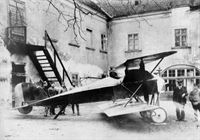P.Grosz, G.Haddow, P.Shiemer Austro-Hungarian Army Aircraft of World War One
Priesel KEP Fighter
Oberleutnant Guido Priesel, a graduate engineer who had built two prewar aircraft in Hohenelbe, Bohemia joined Flars in February 1915 after he was wounded on active service. As a Flars weapons expert, Priesel was instrumental in developing the Type II VK machine gun canister, bomb racks and release mechanisms, and a successful synchronization system. In April 1917, Priesel was given leave to manage the construction of his third aircraft, a monoplane, as a private venture undertaking of Petera & Sohne in Hohenelbe. The monoplane's fabrication, under the supervision of Leutnant Arthur Olessak, was virtually complete and awaiting installation of a 145 hp Hiero engine which Flars had provided when Priesel stopped the project in September 1917 in favor of a new biplane fighter.
For Petera, a small coach builder, the project had become too expensive, forcing Priesel to join forces with Karl Hoier, a factory owner in Fischamend who provided financial backing in return for which, it appears, he obtained the rights to Priesel's various patents. The new venture was named Wieland Technische Werkstatte. Olessak, assisted by Leutnant Hans Stephenson and Flars engineer Robert Gabriel, supervised the construction of the Priesel KEP (Kampfeinsitzer Priesel) for which Flars had assigned four workers. Another 16 workers were detached to fabricate 150 observer's machine-gun fixtures designed and patented by Priesel.
As proposed to Flars, the advantages of the Priesel KEP were improved pilot visibility, minimum weight (less than the Aviatik D.I), an unsynchronized machine gun mounted on the upper wing, a wing cellule free of fuselage interference drag, and minimal wing bracing. Because of the novel design, the static calculations prepared by Stephenson in March 1918 were rejected by Flars. Army pilots were prohibited from flying the aircraft.
After Priesel was killed in a crash while engaged in Flars weapon experiments on 20 March 1918, Major von Petroczy was given the task of preparing the aircraft for flight testing. According to Stephenson, civilian test pilot Karl Kriger fearlessly flew the aircraft to Aspern on its maiden flight on 6 April 1918 and performed one or two additional flights. In view of unsatisfactory wind tunnel tests, Flars recommended on 5 August 1918 a complete reconstruction, namely replacing the tail empennage, rear fuselage and wing profile and exchanging wing warping for aileron control. A lighter but more powerful rotary engine would replace the 145 hp Hiero engine. These plans never materialized. The Priesel KEP was offered for sale to the Czechoslovakian government in 1920.
E.Hauke, W.Schroeder, B.Totschinger Die Flugzeuge der k.u.k. Luftfahrtruppe und Seeflieger 1914-1918
Die Priesel DD ist eine Konstruktion von Hptm Guido Priesel, die dem Fliegerarsenal zugeteilt war. Gebaut wurde das Flugzeug in Hohenelbe, Böhmen. Ob die Maschine je fertiggestellt und geflogen wurde, ist nicht bekannt. Hptm Priesel verunglückte mit Fokker B.I 03.15 am 21. März 1918 tödlich.
Priesel DD - это конструкция капитана Гвидо Приезеля, которая была передана в авиационный арсенал. Самолет был построен в Гогенельбе, Богемия. Неизвестно, была ли машина когда-либо доработана и запущена. Hptm Priesel попал в аварию с Fokker B.I 03.15 21 марта 1918 года.
 |
P.Grosz, G.Haddow, P.Shiemer - Austro-Hungarian Army Aircraft of World War One /Flying Machines/
|
| The Priesel KEP prototype in the courtyard of the Wieland factory at Fischamend. The attention to streamling is reflected in the careful fairing of the radiator, engine, and cooling system.
|
 |
P.Grosz, G.Haddow, P.Shiemer - Austro-Hungarian Army Aircraft of World War One /Flying Machines/
|
The Priesel KEP. The absence of center section bracing is remarkable, in fact the entire wing cellule is solely supported by the rear undercarriage struts, two lower fuselage struts, and interplane wire bracing.
Priesel-Versuchsdoppeldecker, Konstruktion von Hptm Guido Priesel
|
 |
E.Hauke, W.Schroeder, B.Totschinger - Die Flugzeuge der k.u.k. Luftfahrtruppe und Seeflieger 1914-1918
|
| Priesel-Versuchsdoppeldecker, 1918
|
 |
P.Grosz, G.Haddow, P.Shiemer - Austro-Hungarian Army Aircraft of World War One /Flying Machines/
|
| The Priesel KEP. It is not clear how the wing warping system worked. According to Stephenson, the entire wing cellule could be tilted in flight. One can only admire Karl Kriger’s reckless courage in piloting this bizarre design on its maiden flight.
|
 |
P.Grosz, G.Haddow, P.Shiemer - Austro-Hungarian Army Aircraft of World War One /Flying Machines/
|
| The Priesel monoplane was nearing completion at Petera & Sohne in Hohenelbe in September 1917, when construction was stopped. In its completed form, wing warping and wire wing bracing probably would have been fitted.
|
 |
P.Grosz, G.Haddow, P.Shiemer - Austro-Hungarian Army Aircraft of World War One /Flying Machines/
|
| Priesel KEP
|







